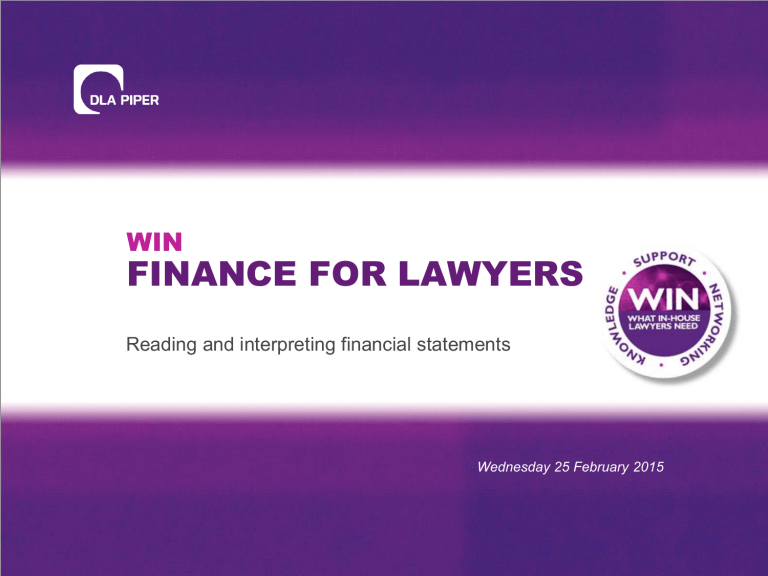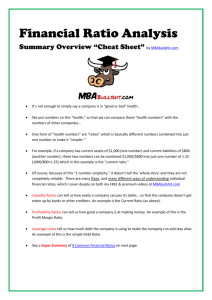FINANCE FOR LAWYERS

WIN
FINANCE FOR LAWYERS
Reading and interpreting financial statements
Wednesday 25 February 2015
FINANCE FOR LAWYERS
READING & INTERPRETING
FINANCIAL STATEMENTS
CHARLES BARNETT
MARK MCCLUSKEY
25 FEBRUARY 2015
SESSION OBJECTIVES
By the end of today you should be able to…
• Demonstrate an understanding of accounting principles and understand how financial information is prepared
• Understand the composition of a set of financial statements, and be able to, at a high level, interpret a set of financial statements
• Understand the judgements or estimates that a preparer of a set of financial statements may have used and the impact these have
AGENDA
TIMING
30 mins
1 hour
1 hour
10 mins
CONTENT
Introduction and Agenda
Explaining Accounting Principles
Understanding Financial Statements
‐ Composition
Interpreting Financial Statements
‐ Ratio analysis & KPIs
‐ Management estimates & judgements
What the future holds
EXPLAINING ACCOUNTING PRINCIPLES
FINANCE FOR LAWYERS
ACCOUNTING: TURNING DATA INTO INFORMATION
• Accounting vs. book keeping
• Sources of requirements:
‐ EU and national law
‐ Accounting standards (UK GAAP & IFRSs)
• Rules vs. principles-based standards
• Underlying concepts and pervasive principles
TYPES OF ACCOUNTING
Accounting
• The process of identifying, measuring and communicating financial information which is useful for economic decision making
• Ultimately accounts provide a narrative on the performance and position of an organisation
Management Accounting
• Provision of information for use within the organisation
Financial Reporting
• Provision of information for external users – mainly investors
TYPES OF ACCOUNTING
Management Accounting
• Internal use
• Designed to meet individual needs
• Both backward and forward looking
• Aids assessment of performance and facilitates planning
• Prepared regularly as needed
• Greater level of detail
• May be subject to internal audit in those entities that have that function and direction from management
Financial Accounting
• External use
• Inflexible formats
• Regulatory compliance
• Historic: backward looking
• Aids assessment of performance and stewardship
• Annually prepared
• Some information aggregated
• Subjected to statutory audit (by external auditors such as BDO
LLP)
ACCOUNTING CONCEPTS
How are financial statements created?
A true & fair view Relevance
Substance over form
Understandable Consistency
Materiality Prudence
Going Concern
Accruals
Separate entity
WHAT ARE THE DIRECTORS’ RESPONSIBILITIES?
In preparing these financial statements, the directors are required to:
• Select suitable accounting policies and then apply them consistently
• Make judgements and accounting estimates that are reasonable and prudent
• State whether applicable UK Accounting Standards have been followed, subject to any material departures disclosed and explained in the financial statements
• Prepare the financial statements on the going concern basis unless it is inappropriate to presume that the company will continue in business.
FINANCIAL STATEMENT COMPONENTS
FINANCE FOR LAWYERS
PRODUCTION OF SET OF FINANCIAL STATEMENTS
How are financial statements created?
Transactions recorded in book of prime entry
Subtotals from
Books of Prime entry post to nominal ledger
Trial Balance extracted
Adjustments made to Trial
Balance (and consolidated?)
Financial
Statements created
PRODUCTION OF SET OF FINANCIAL STATEMENTS
How are financial statements created?
Auditors will performing testing on this element and will raise audit adjustments
Transactions recorded in book of prime entry
Subtotals from
Books of Prime entry post to nominal ledger
Trial Balance extracted
Adjustments made to Trial
Balance (and consolidated?)
Financial
Statements created
In most clients, this will be performed by an accounting package
Approved by Board
Performed by the accounting function, FC, FD, CFO
WHAT’S IN AN ANNUAL REPORT
WHAT’S IN AN ANNUAL REPORT?
Directors’
Report
Report of
Independent
Auditors
Strategic
Report
Directors’
Remuneration
Report
Corporate
Governance
Report
Profit & Loss
Account /
Income
Statement
Notes to the
Financial statements
STRGL / OCI
Cash flow statement
Balance Sheet
/ Statement of
Financial Position
Statement of Changes in Equity
UK GAAP AND IFRSs – TERMINOLOGY DIFFERENCES
UK GAAP
• Profit & loss account (‘P&L’)
• Balance sheet
• Statement of total recognised gains & losses (‘STRGL’)
• Turnover
• Interest payable
• Tax
• Fixed assets
• Debtors
• Creditors
• Creditors: amounts falling due within one year/ over one year
IFRSs
• Income statement
• Statement of financial position
• Statement of comprehensive income
• Revenue
• Finance cost
• Income tax expense
• Non-current assets
• Receivables
• Payables
• Current liabilities/Non-current liabilities
THE FINANCIAL STATEMENTS
The primary statements
Income Statement
• Performance
Opening
Statement of Financial
Position (Balance Sheet)
• Financial position
• Solvency
• Available funds
Statement of Comprehensive
Income
• Other gains and losses
Statement of Changes in
Equity
• Transactions with shareholders
Closing
Statement of Financial
Position (Balance Sheet)
• Financial position
• Solvency
• Available funds
Cash Flow Statement
• Liquidity
INCOME STATEMENT
Revenue
Cost of sales
Gross profit
Other operating income
Administrative expenses
Distribution expenses
Profit from operations
Finance expense
Finance income
Share of post-tax profits of associates
Profit before tax
Tax expense
Profit from continuing operations
Note
4
5
6
9
9
10
2014
£’000
175,278
(138,410)
36,868
1,283
(9,164)
(9,624)
19,363
(584)
825
960
20,564
(2,782)
17,782
2013
£’000
166,517
(131,579)
34,938
1,203
(9,919)
(10,101)
16,121
(842)
1,491
931
17,701
(4,209)
13,492
WHAT DOES A BALANCE SHEET TELL US?
Top ‘half’ of balance sheet
Assets to be utilised and safeguarded
LESS
Liabilities and obligations incurred to date
EQUALS
Shareholder Equity (i.e. what is owed to the shareholders as investors in the company)
Bottom ‘half’ of balance sheet
BALANCE SHEET
A snapshot of the business at a particular point in time
“Balance sheet AS AT” a particular date
Provides a picture of the company’s financial position
What the company
HAS less what the company OWES
ASSETS - WHAT WE HAVE
Right or other access to future economic benefits as a result of past transactions or events:
• Fixed Assets - Those held for continuing use in the business rather than for resale
• Current Assets - Acquired with the intention of use/disposal within a year
ASSETS - EXAMPLES
Fixed
• Land and buildings
• Plant and machinery
• Fixtures and fittings
• Motor vehicles
• Investments
Current
• Stock
(raw material, work-in-progress, finished goods)
• Debtors
(trade, other, prepayments, accrued income)
• Short-term investment
• Cash at bank
• Cash in hand
LIABILITIES - WHAT WE OWE
An obligation to transfer economic benefits as a result of past transactions:
• Current liabilities - Amounts due for payment within one year
• Long-term liabilities - Amounts due for payment after more than one year
• Categorised by the Companies Act as “Creditors”
LIABILITIES - EXAMPLES
Current
• Bank overdraft
• Trade creditors
(Owed for purchases)
• Accruals
• Lease payments/loan repayments due within one year
Long-term
• Debenture loan stock
• Mortgages
• Lease payment/loan repayments due after more than one year
BOTTOM HALF OF BALANCE SHEET
CASH FLOW STATEMENT
Areas of focus
INTERPRETING FINANCIAL STATEMENTS
FINANCE FOR LAWYERS
WHO MIGHT READ THE ANNUAL REPORT AND WHY?
Suppliers
Regulators
(CRRP)
Providers of finance
Employees
Shareholders
Directors /
Management
Lawyers
Competitors
Government
(Tax)
USING RATIOS
Types of ratios
WHY ARE RATIOS USEFUL?
1.
Identification of trends
2.
Quick measurement
3.
Overcomes problems of scale
4.
Easy to calculate
5.
Used with sector knowledge
TYPES OF RATIOS
• Profitability
• Efficiency
• Liquidity
• Investment/Gearing
EXAMPLE RATIOS
CONSIDER KEY PERFORMANCE INDICATORS (KPI)
• Performance
Turnover growth | Like for Like
Gross | operating | net margin
Earnings before interest, tax & depreciation (‘EBITDA’)
Profit to cash conversion
Return on capital employed
Sector specific
• Interaction with financial covenants
Interest cover (EBITDA / Finance cost)
Senior debt cover (Net debt / EBITDA)
Cash flow available for debt service (CFADS / Finance cost)
UNDERSTANDING THE BUSINESS
Different focus?
INCOME
• Performance
• Margin | EBITDA
• Working capital
• Operating - Retail, Professional service, Leisure & Hospitality
CAPITAL
• Position
• Return on capital employed
• Gearing
• Leveraged - Real Estate, Natural
Resources, Financial Services
MANAGEMENT ESTIMATES & JUDGEMENT
Impact on the financial statements
Impact of:
• Accounting principals:
True and fair
Substance over legal form
• Preparation of financial statements:
Post trial balance adjustments
Judgement areas
• Management motivations:
Attitude / perception of risk
Remuneration – income or capital growth
Covenant headroom
Business aspirations
EXERCISE
Understanding the business
Working in your tables, consider the set of financial statements provided and discuss:
• What areas of the financial statements would you be interested in?
• What ratios or KPIs do you think are relevant?
• What levels of management estimate or judgement are included in the financial statements
You have 15 minutes for this activity
WHY DO PROFITABLE COMPANIES FAIL?
• Lack of cash – ‘CASH IS KING’
• Surpluses do not equal cash
– Accruals
– Prudence
– Accounting non-cash entries (eg depreciation)
– Cash entries not recorded in the P&L (eg purchasing fixed assets).
Does an entity’s cash flows arise evenly over the year?
AREAS OF POTENTIAL JUDGEMENT
Keeping the cash moving
Sell stock/ inventory
Cash received from customer
Credit period given
Stock holding period
Credit period taken Funding period
Buy inventory
Pay our supplier
INDICATORS OF OVERTRADING
What could tell us something is wrong?
• Finance available cannot support level of trading
• Results indicate liquidity problems
• Current ratio declines
• Higher debtor days
• Higher creditor days
• Lower stock days
• Trend analysis relative to competitors/market
WHAT DOES THE FUTURE HOLD?
FINANCE FOR LAWYERS
THE SHAPE OF THINGS TO COME…
Recent and up-coming changes
• New UK GAAP
• Narrative reporting
‐ Directors’ report
‐ Strategic report
‐ Corporate governance (Going concern)
• Audit reporting (ISA 700)
• Changes to IFRSs
‐ Leases
‐ Revenue
‐ Financial instruments
SESSION OBJECTIVES - REMINDER
By the end of today you should be able to…
• Demonstrate an understanding of accounting principles and understand how financial information is prepared
• Understand the composition of a set of financial statements, and be able to, at a high level, interpret a set of financial statements
• Understand the judgements or estimates that a preparer of a set of financial statements may have used and the impact these have
THANK YOU
Any further questions please contact us
CHARLES BARNETT
Partner
Audit t: +44 (0)141 249 5233 e: charles.barnett@bdo.co.uk
MARK MCCLUSKEY
Director
Audit t: +44 (0)141 249 5230 e: mark.mccluskey@bdo.co.uk
WIN
FINANCE FOR LAWYERS
Reading and interpreting financial statements
Wednesday 25 February 2015




